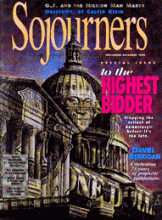Building peace is a hard job; it takes lots of work. Some of that work is being done by writers and artists who share their peace vision in literature for children. Sharing stories-passing them on-is one of the most human, rewarding, and endearing methods of education.
The American Booksellers for Children has a program, "Twenty Minutes a Day," which advocates adults reading to children each day. What a wonderful goal and goad to do what we desire! Here are some stories to share in that time together or to suggest for read-alone times.
The commemoration of the dropping of the atomic and plutonium bombs on Hiroshima and Nagasaki respectively prompted authors to address the issue with children. In On the Wings of Peace: Writers and Illustrators Speak Out for Peace in Memory of Hiroshima and Nagasaki, 60 international authors and artists share their vision for peace.
The opening essay, "World War II in the Pacific," by Greg Mitchell, is an account of the events of the war and the dropping of the bombs. He presents the differing beliefs of military and political leaders on the use of the bombs. This essay is a foundation for the consideration of those events, as experienced in true accounts through poetry, art, and story, gathered together in this volume.
Not all the writing is focused on the World War II events, but all is centered in the desire and need for peace. Bruchac's "A Story of the Peacemaker" (from the Seneca nation), Milton Meltzer's "The Dissenters" (documenting the Friends and other conscientious objectors), and Katharine Paterson's story of "The Grandmother With Her Own Bomb" (based on a true experience in Russia) are stories to share. This volume includes writers from the world's "trouble spots" who write with a passion for peace in a work for adults as well as young people.
Read the Full Article
